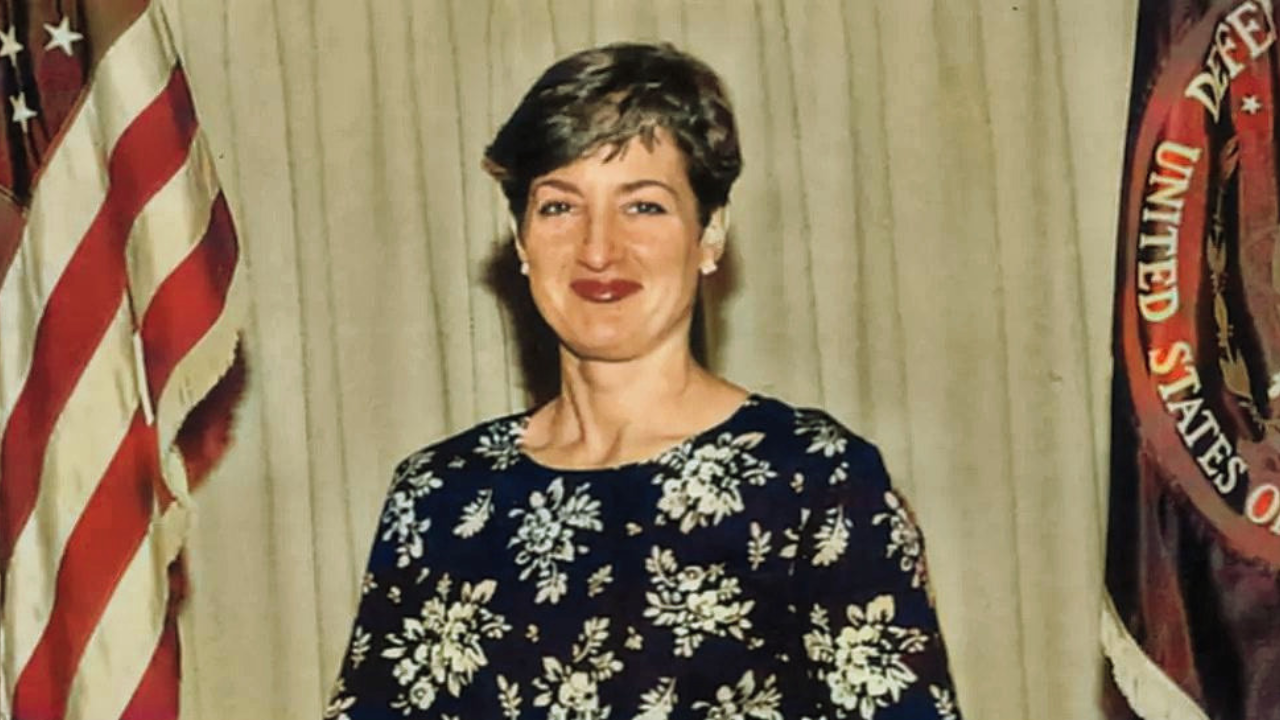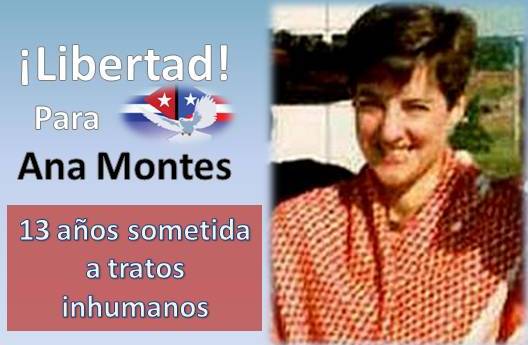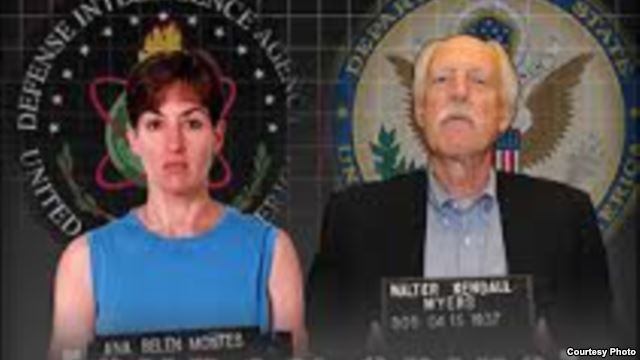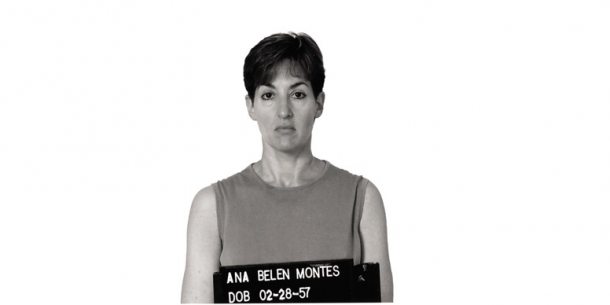- by Edwin Chungo Molina
- InformacionalDesnudo – Miami, Florida
-
Ana Belén Montes is a former senior analyst at the Defense Intelligence Agency in the United States. On September 21, 2001, she was arrested and subsequently charged with conspiracy to commit espionage for the government of Cuba.Ana Belén Montes[1] (born February 28, 1957) is a former senior analyst at the Defense Intelligence Agency in the United States. On September 21, 2001, she was arrested and subsequently charged with conspiracy to commit espionage for the government of Cuba. Montes eventually pleaded guilty to spying and in October 2002, was sentenced to a 25-year prison term followed by five years’ probation.[2][3]
-
Montes was born in West Germany, where her father, Alberto Montes, was posted as an Army doctor.[3] Her family members were of Asturian origins since her grandparents had emigrated to Puerto Rico.[1] The family later lived in Topeka, Kansas and then Towson, Maryland, where she graduated from Loch Raven High School in 1975. In 1979 she earned a degree in foreign affairs from the University of Virginia, and in 1988 she finished a master’s degree at Johns Hopkins University School of Advanced International Studies.[3]
Montes’ brother and sister, Tito and Lucy, became FBI officers and her former boyfriend, Roger Corneretto, was an intelligence officer specializing in Cuba for the Pentagon.[4] It was later revealed that her Puerto Rican father had conservative views, and had a strained relationship with his more radical daughter.
Ana Montes receiving an award from CIA director George TenetMontes joined the DIA from the United States Department of Justice in September 1985. Her first assignment was at Bolling Air Force Base in Washington where she worked as an intelligence research specialist. In 1992, Montes was selected for the DIA’s Exceptional Analyst Program and later traveled to Cuba to study the Cuban military.[3]
Prior to her arrest, she lived in a two bedroom co-op in Cleveland Park, Washington, DC.[3]Montes advanced rapidly through the ranks at DIA and became its most senior Cuban analyst.[citation needed] Her co-workers regarded her as responsible and dependable, and noted her «no-nonsense» attitude. Prosecutors would later allege that Montes was already working for the Cubans when she joined the DIA in 1985.[3]
Espionage
In their charging documents, federal prosecutors stated:[3]
«Montes communicated with the Cuban Intelligence Service through encrypted messages and received her instructions through shortwave encrypted transmissions from Cuba. In addition, Montes communicated by coded numeric pager messages with the Cuban Intelligence Service by public telephones located in the District of Columbia and Maryland. The codes included ‘I received message’ or ‘danger.'»
The prosecutors further stated that all of the information was on water-soluble paper that could be rapidly destroyed.
During the course of the investigation against her, it was determined that Montes had passed a considerable amount of classified information to the Intelligence Directorate, including the identities of four US spies. In 2007, DIA counterintelligence official Scott W. Carmichael publicly alleged that it was Ana Montes who told Cuban intelligence officers about a clandestine US Army camp in El Salvador. Carmichael alleged that Montes knew about the existence of the Special Forces camp because she visited it only a few weeks before the camp was attacked in 1987 by Cuban-supported guerrillas of the Farabundo Martí National Liberation Front.
Carmichael, who had led DIA’s investigation of Montes, named Montes as being directly responsible for the death of Green Beret SGT Gregory A. Fronius who was killed at El Paraíso, El Salvador, on March 31, 1987 during the FMLN attack. Carmichael characterized the damage Montes caused to the DIA and other US intelligence agencies as «exceptionally grave,» and stated that she compromised a «special access program» that was kept even from him, the lead investigator on her case.[5]
In a May 6, 2002 interview with CBS News, former Undersecretary of State John Boltonstated that an official 1998 US government report with significant contributions by Montes concluded that Cuba did not represent a significant military threat to the United States or the region. Bolton alleged that it was not possible to exclude the possibility that the administration of President Bill Clinton may have overlooked Cuba as a potential threat because of Montes’ influence and the way she shaped reporting at DIA.[6]
Carmichael further alleged that many in the US intelligence community believed that Montes’ penetration of the DIA was not the exception, but the rule, and that the Cuban intelligence services had numerous spies and moles within US intelligence agencies.[5]
In 2004 a Federal indictment alleged that Montes had assistance from another Cuban agent, Marta Rita Velazquez, once a legal officer at the State Department’s Agency for International Development, who also was alleged to have recruited Montes into espionage. The Federal indictment was unsealed in April 2013. Velazquez has been outside the US since 2002, apparently in Sweden, which does not have an extradition treaty with the US for spy cases.[7]
Arrest
Montes was arrested by the Federal Bureau of Investigation at her office on 20 September 2001. Prosecutors stated that Montes had been privy to classified information about the US military‘s impending invasion of Afghanistan in October 2001, and that they did not want her revealing this information to potential enemies.[3]
In 2002, Montes pleaded guilty to the charge which could have carried the death penalty, but was sentenced to 25 years in prison in October of the same year after accepting a plea agreement with the US government.[3] According to her lawyer, Plato Cacheris, Montes committed the espionage for moral reasons, as «She felt the Cubans were treated unfairly by the U.S. government.»
Incarceration
Montes is currently incarcerated at FMC Carswell in Fort Worth, Texas.[3] FMC Carswell is listed by the Federal Bureau of Prisons as a facility located in the northeast corner of the Naval Air Station, Joint Reserve Base, Fort Worth, which provides specialized medical and mental health services to female offenders.
Montes is listed as FMC Register #25037-016. Her tentative release date is listed as July 1, 2023. There is no parole in the US federal prison systemReferentes
- Oviedo, María José IGLESIAS. «Ana Montes, la asturiana que espió para Fidel.» La Nueva España. 28 April 2013. «Ana Belén Montes, nieta de asturianos del oriente de la región que emigraron a Cuba y Puerto Rico,[…]»
- «An Unrepentant Montes Sentenced to 25 Years». The Centre for Counterintelligence and Security Studies. October 2002.
- Popkin, Jim. Ana Montes did much harm spying for Cuba. Chances are, you haven’t heard of her. Washington PostMagazine, April 18, 2013.
- Popkin, Jim. Ana Montes did much harm spying for Cuba. Chances are, you haven’t heard of her. April 18, 2013
- Bill Gertz (March 2007). «DIA official warns about Cuban spies». Washington Times.
- Bolton, John. «John R. Bolton, Under Secretary for Arms Control and International Security, «Beyond the Axis of Evil: Additional Threats from Weapons of Mass Destruction,» Remarks to the Heritage Foundation, Washington, DC, May 6, 2002″. Vincent Ferraro, Mount Holyoke College. Retrieved 8 July 2012.
- Charge in Cuban spy case unsealed, accusing ex-State Dept. officer of conspiracy. Washington Post/ Associated Press, Thursday, April 25, 2013.
- Carmichael, Scott W. True Believer: Inside the Investigation and Capture of Ana Montes, Cuba’s Master Spy. Annapolis MD: U.S. Naval Institute Press, 2007. [1]
- Washington Times article, Bill Gertz, March 15, 2007.DIA Official Warns About Cuban Spies
- Bureau of Prisons Inmate Locater for Ana Montes
- CBS News interview of former Undersecretary of State John Bolton [2]
- Cereijo, Manuel. Ana Belen Montes: The chronicle of an American Spy for the Cuban Government.[3]
- The Miami Herald article, October 16, 2002.Statement by Ana Belen Montes, who received 25-year sentence for spying for Cuba.[4]
- The Washington Post Magazine article, April 18, 2013. «»Ana Montes did much harm spying for Cuba. Chances are, you haven’t heard of her.[5]
Further reading
- «FBI 100 The Case of the Cuban Spy.» Federal Bureau of Investigation.
- Marquis, Christopher. » The New York Times. October 20, 2001. Retrieved on January 27, 2014. US restricts Cuban Diplomats in Capital after spy charges
—Miami Herald—Recent declassifiedy informationAna Montes spent almost 20 years spying for Cuba while working as a U.S. intelligence analyst. Here, her FBI booking photo on the day of her arrest, Sept. 21, 2001. The «Queen of Cuba» is one of America’s most harmful spies, but few have heard of her. | THE WASHINGTON POSTBY BRIAN LATELLFor 16 years, Ana Belen Montes spied for Cuba from increasingly responsible positions at the Defense Intelligence Agency. If Havana has ever run a higher level or more valuable mole inside the American defense establishment, that has never been revealed.
When she was arrested in late September 2001, Montes was about the equivalent in rank of a colonel. She had access to sensitive compartmented intelligence. Strangely, for one so openly enamored of Fidel Castro, her superiors considered her one of the best Cuba analysts anywhere in government.
Despite the importance of her case, some of the most tantalizing questions about her spying have never been publicly answered. Could the calamity of her treason have been avoided? What was learned about Cuban intelligence tradecraft? How was she discovered? And, of enduring concern, did she work with other American spies thus far undetected or not prosecuted?
Thanks to researcher Jeffrey Richelson and the National Security Archive, new light has finally been shed on the Montes case. Because of their efforts, a 180 page study completed by the Department of Defense Inspector General in 2005 has recently been declassified. It is heavily redacted; many pages, including the CIA’s extensive comments, blacked out. Yet, a quantity of surprising new details are now on the public record.
Montes’s decision to spy for Cuba was “coolly deliberate.” Enticed by a Cuban access agent in Washington, they traveled together to New York in December 1984. Montes met with intelligence officers posted under cover at the Cuban mission to the United Nations.
She “unhesitatingly agreed” to work with them and travel clandestinely to Cuba as soon as possible. The following March, she went there via Spain and Czechoslovakia. The Pentagon report does not state the obvious: while there, she must have received specialized training in intelligence tradecraft.
Then, with Cuban encouragement, she applied for a job at DIA. A standard background investigation was conducted, but we now know that serious concerns about her suitability were raised. Without elaboration, the Pentagon report indicates that they included “falsification of her Master of Arts degree from Johns Hopkins (University) and her trustworthiness.”
DIA did not require applicants to submit to a pre-employment polygraph exam. So, Montes, a trained Cuban espionage agent with a problematic past was cleared and hired. She began her double duties in September 1985.
After her arrest, Montes insisted that she had the “moral right” to provide information to Cuba. In her view, she did not work forCuba, but with Cuban officials. They felt “mutual respect and understanding” she thought, as “comrades in the struggle.”
The Cubans were skilled in manipulating and controlling her. She told interrogators after her apprehension that she considered herself the equal of her “Cuban comrades, not a menial espionage tool.” They let her believe she “maintained significant control,” although she consistently left “security matters, including meeting site security, countersurveillance, and transmission security” to her handlers.
Montes said they were “thoughtful, sensitive to her needs, very good to me.” They went to “special lengths to assure her they had complete confidence in her.” They allowed her a long, loose leash, easier because they were not paying for her extraordinary services.
Initially in New York, and later at her request in the Washington area, she met with her handlers as often as once every two or three weeks, usually on weekends. Everything about her second covert trip to Cuba is redacted in the Pentagon report.
In 1991, Montes underwent a seemingly routine security reinvestigation. She was asked about foreign travel, and lied. Questioned about inaccuracies in her original application for employment, she confessed that she had misrepresented an incident in her past. Feigning innocence, Montes claimed that she “did not understand the seriousness of being truthful and honest at the time.”
Her questionable case was then reviewed at a higher level. The adjudicator reported that “while Montes seemed to have a tendency ‘to twist the truth’ to her own needs and her honesty was still a cause of concern, adverse security action was unlikely.” Again, she had slipped through. Her high level clearances were recertified.
Soon after, she brazenly submitted a freedom of information request for her own government records. She must have been concerned that something adverse had been discovered. Investigative material was released. She gave the surprised Cubans copies.
She apparently visited Cuba a third time after being selected to participate in the prestigious Director of Central Intelligence “Exceptional Analyst Program” in 1992. This time her travel to the island, purportedly to conduct research, was legal.
In 1996, she was questioned by a DIA special agent after another DIA employee reported concerns about her. Serious doubts were raised about her veracity, but the allegations could not be substantiated.
None of this seems to have contributed to her eventual unmasking. So, how was she discovered? Surprisingly, revealing information seeps through the Pentagon’s report. “We got lucky,” a counterintelligence official observed. An entirely blacked-out section entitled “Serendipity” suggests the same.
By April 1998, a coordinated search for a Cuban spy was underway, according to the report. At first it was thought most likely the quarry was a CIA employee. Investigators were following a crucial clue: the unknown spy had apparently traveled to the Guantanamo naval base as Montes had apparently done on official DIA business.
The breakthrough had seemingly come earlier, however. According to the Pentagon report, Montes was informed shortly after her arrest that investigators “had information from a senior official in the Cuban intelligence service concerning a Cuban penetration agent that implicated Montes.” It appears that this information propelled the investigation that resulted in her arrest.
Who was this mysterious, previously unacknowledged source? From the language of the Pentagon report, it was probably not a defector, but more likely a renegade or compromised Cuban intelligence officer. If so, Montes was done in by one of her own so-called “comrades.”
Did she work with other American spies? The report is ambiguous; it states that after the terrorist attacks on September 11, 2001 pressure intensified to arrest Montes. The FBI preferred to wait, however, in order “to monitor Montes’s activities with the prospect that she may have eventually led the FBI to others in the Cuban spy network.”
Did government censors inadvertently confirm the existence of a larger spy ring? If in fact there was evidence of one, it may be a long time before more is known.
It is now clear, however, that Montes’s apprehension was not just the result of excellent intelligence work. She told investigators after her arrest that a week earlier she had learned that she was under surveillance. She could have decided then to flee to Cuba, and probably would have made it there safely.
But she said that “she couldn’t give up on the people (she) was helping.” Montes is serving a 25 year prison sentence.
—FBI News—
FBI 100
The Case of the Cuban Spy
Just 10 days after the attacks of 9/11, the FBI arrested a 44-year-old woman named Ana Belen Montes.
She had nothing to do with the terrorist strikes, but her arrest had everything to do with protecting the country at a time when national security was of paramount importance.
Ana Belen Montes Montes, it turned out, was spying for the Cubans from inside the U.S. intelligence community itself—as a senior analyst with the Defense Intelligence Agency, or DIA. And she was soon to have access to classified information about America’s planned invasion of Afghanistan the following month.
Montes was actually the DIA’s top Cuban analyst and was known throughout the U.S. intelligence community for her expertise. Little did anyone know how much of an expert she had become…and how much she was leaking classified U.S. military information and deliberately distorting the government’s views on Cuba.
It began as a classic tale of recruitment. In 1984, Montes held a clerical job at the Department of Justice in Washington. She often spoke openly against the U.S. government’s policies towards Central America. Soon, her opinions caught the attention of Cuban “officials” who thought she’d be sympathetic to their cause. She met with them. Soon after, Montes agreed to help Cuba.
She knew she needed a job inside the intelligence community to do that, so she applied at DIA, a key producer of intelligence for the Pentagon. By the time she started work there in 1985, she was a fully recruited spy.
Montes was smart. To escape detection, she never removed any documents from work, electronically or in hard copy. Instead, she kept the details in her head and went home and typed them up on her laptop. Then, she transferred the information onto encrypted disks. After receiving instructions from the Cubans in code via short-wave radio, she’d meet with her handler and turn over the disks.
During her years at DIA, security officials learned about her foreign policy views and were concerned about her access to sensitive information, but they had no reason to believe she was sharing secrets. And she had passed a polygraph.
Her downfall began in 1996, when an astute DIA colleague—acting on a gut feeling—reported to a security official that he felt Montes might be under the influence of Cuban intelligence. The official interviewed her, but she admitted nothing.
The security officer filed the interview away until four years later, when he learned that the FBI was working to uncover an unidentified Cuban agent operating in Washington. He contacted the Bureau with his suspicions. After a careful review of the facts, the FBI opened an investigation.
Through physical and electronic surveillance and covert searches, the FBI was able to build a case against Montes. Agents also wanted to identify her Cuban handler and were waiting for a face-to-face meeting between the two of them, which is why they held off arresting her for some time. However, outside events overtook the investigation—as a result of the 9/11 attacks, Montes was about to be assigned work related to U.S. war plans. The Bureau and DIA didn’t want that to happen, so she was arrested.
What was Montes’ motivation for spying? Pure ideology—she disagreed with U.S. foreign policy. Montes accepted no money for passing classified information, except for reimbursements for some expenses.
Montes, who acknowledged revealing the identities of four American undercover intelligence officers working in Cuba, pled guilty in 2002 and was sentenced to 25 years in prison.






3 comentarios en “Free Ana Belen Montes Lopez…Puerto Rican Political Prisoner / Libertad para Ana Montes…Boricua como Yo!!”
Nació en Alemania. nada de Puertoriqueña de nada
Hola, gracias por tu interés, pero en realidad Ana Belén Montes nació en Alemania solo porque su padre puertorriqueño estaba prestando servicio militar como médico allí, ella es y siempre ha sido puertorriqueña.
Me parece que la mayoría de las fotos que aparecen en este artículo pertenecen a la cantante española Ana Belén; no a Ana Belén Montes, verifiquen eso por favor. De todos modos, gracias por este trabajo.